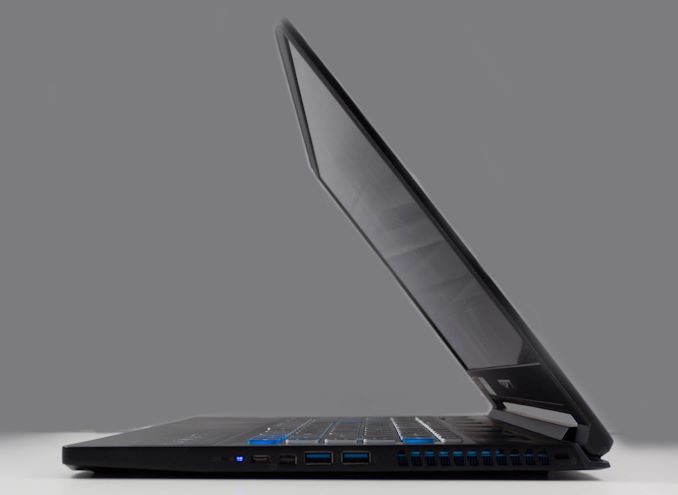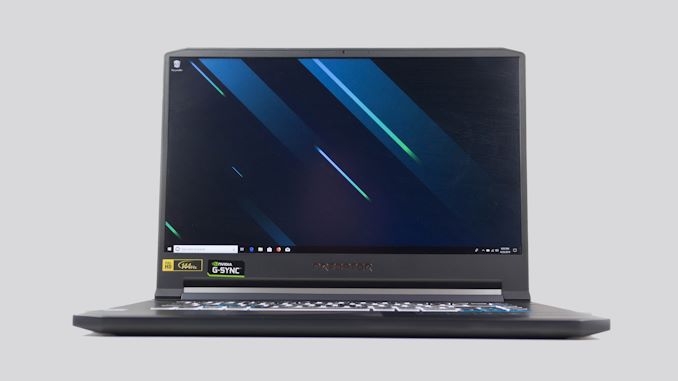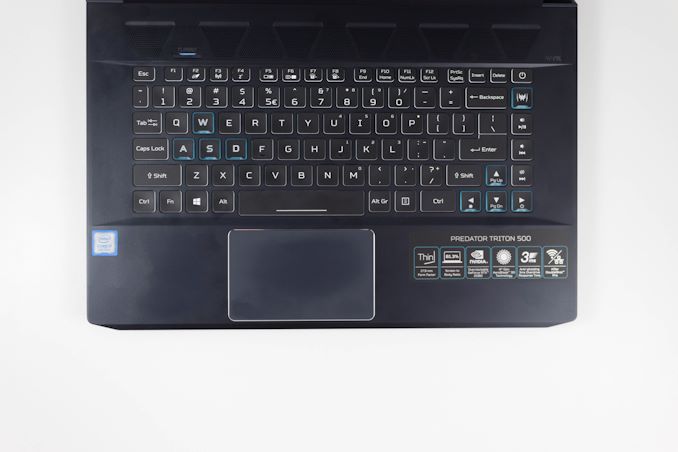The Acer Predator Triton 500 Laptop Review: Going Thin with GeForce RTX 2080
by Brett Howse on April 25, 2019 8:00 AM ESTDesign
When you think of gaming laptops, you generally think big and heavy, which makes sense due to the power requirements of top-end gaming components. A bigger laptop offers more thermal mass, and it also offers more room for cooling fans, both of which are a big help in terms of keeping a gaming laptop cool. That being said, the efficiency of modern CPUs and GPUs is at the point where you can now entertain a thin and light gaming laptop. Acer is certainly not the first to do this of course, but picking up the Predator Triton 500 for the first time drives home just how far GPUs have come, and with NVIDIA’s Max-Q program, they really can fit the top tier GPU in a thin and light chassis. At just 0.7-inches, or about 18mm thick, the Predator Triton 500 isn’t much thicker than an Ultrabook, and at 4.63 lbs, or 2.1 Kg, it is reasonably light as well.
The thin design and light weight start with the chassis, which Acer has crafted out of aluminum. On a premium laptop design, this is expected, and Acer’s execution is top-notch. The Predator logo is backlit in blue on the top of the system, but other than that the design is more muted than many gaming systems, which I think a lot of people will appreciate. Acer has also angled the top corners slightly, which is a nice touch. It’s a simple, but well-executed design.
Opening the laptop up, Acer has also jumped on another very welcome trend, offering minimal display bezels around the 15.6-inch display. There’s a bit of a chin on the bottom, which can’t be avoided if you want to fit all of the cooling and circuit boards inside. It’s true that a taller aspect ratio would solve this issue, but there is no way Acer could have found a 144 Hz IPS display panel in a 3:2 aspect, so keeping the three bezels to a minimum seems like the right solution. The angled corners at the top also allow Acer to fit the webcam in above the display.
The keyboard layout works well, offering six rows of keys. Some 15.6-inch laptops take the route of offering a number pad, which never really works well due to the narrow keyboard deck, and likely the thin bezel design wouldn’t even allow this on the Triton 500, but Acer has fit in a row of media keys, which also offers a Predator key to launch their PredatorSense software, as well as the power button. I generally frown on having the power button be a key on the keyboard, and would prefer a separate key to avoid accidentally hitting it, but since it’s slightly removed from the normal keyboard layout, this isn’t as big of a con.
The keys themselves offer backlighting, but unlike some of the competition which offers per-key RGB LEDs, Acer only allows you to customize them in three zones. Per-key RGB may seem like a gimmick, but it’s actually quite handy to color code one or two keys so you can easily find them. Acer does offer RGB backlighting though, which can be adjusted through their software, so you can pick your color, or choose one of the pre-selected layouts. One other small negative is that the backlighting isn’t activated when the trackpad is being used, so you have to be actually typing on the keyboard to activate the lighting, and keep it active. That’s not always ideal, and I prefer when backlighting is activated by both the keyboard and track pad.
Typing on the keyboard is surprisingly good. The keys are well-spaced and offer enough travel that it’s easy to get accustomed to typing on this laptop. The arrow keys are all full sized, although they do shrink the right shift key, that’s generally not an issue.
Acer’s track pad is also excellent. It is easy to be precise with it, and the trackpad is just the right size. The surface is very smooth, and I never had any issues using multi-touch gestures either. PCs have come a long way here, and it’s nice to see the adoption of the precision touchpad across so many laptops.
The left side of the laptop offers power, Ethernet, USB, HDMI, and the two audio jacks. The right side has two more USB ports, the USB Type-C port for Thunderbolt, and a mini DisplayPort output. There’s plenty of IO available, but if I was nit-picking, the layout of the cooling vents on the side block where the power cable would normally go, and considering this laptop is meant to be plugged in pretty much all of the time, having the power connector where it is makes for somewhat awkward cable management. Acer has tried to help out here by having a 90° connector, but it still isn’t ideal.
But other than that small complaint, Acer hits a lot of good notes on their design and execution of the Predator Triton 500. For a gaming laptop, it strikes a nice balance between usability, design, and functionality. The thin design and light weight make it exceptionally portable. Coupled to that is the modern thin-bezel look. Acer has designed a great looking laptop in the Predator Triton 500.















46 Comments
View All Comments
shabby - Thursday, April 25, 2019 - link
Is it really a 2080 when the base clock is cut in half?Daeros - Thursday, April 25, 2019 - link
No, but that's nvida's game - they can honestly say it's the same chip, even though performance is a few steps down in the hierarchy. Just like that 8750h's TDP is nowhere near 45w - probably closer to 120w under load.Opencg - Thursday, April 25, 2019 - link
you can see in the cpu benchmarks that draw real power for a significant portion of time that it loses a good deal of performance. all in all its about where it should be for a laptop this thin. i would be surprised if it is really designed to handle more than 45w. personally i would bet it can start to throttle on sustained 45w loadsphilehidiot - Thursday, April 25, 2019 - link
I saw the 2080 and then the screen resolution. In reality, you'd probably want 4K + gsync for a shortish lifespan machine or 1440P for one with a good few years on it. 1080P says the performance is compromised and they HAD to drop it down. You'd never ever run a desktop on a 2080 with 1080P. I bought a gaming laptop once when I had a real need for it, back in the P4 days. The thing had about 6 fans and chucked out 50C hot air. I required it at the time but I'd never buy one now unless I absolutely needed it. That had 1050 lines, so 1080 isn't really a step up, it's a marketing ploy ("FULL HD!")This GPU can not be considered alongside a real 2080 and whilst I appreciate the screen size means resolutions greater that 1440P would be silly (and arguably even that but you must remember you're usually closer to a laptop screen and even a 6" mobile can benefit from the upgrade from 1080 to 1440), to me a gaming laptop generally is 17" anyway. If you go down this path you're rarely looking for real portability but more because you (in my experience) live in two or three different places and want to take a full gaming PC with you with your suitcase and so on.
wintermute000 - Thursday, April 25, 2019 - link
Exactly, a 2060 would have been perfect for 1080p 144hz and then maybe the cooling would have coped.Must be a marketing decision to shove the biggest number into the spec sheet....
PeachNCream - Friday, May 3, 2019 - link
I would not mind the slightest pushing 1080p resolutions with a 2080 GPU, but not with this particular laptop given the network adapter selection. It just isn't worth messing with Killer NICs at all when there are other options out there.wintermute000 - Thursday, April 25, 2019 - link
a.) The TDP as defined by intel (i.e. base clock) IS 45W.b.) Power under boost is much higher for sure, but 120W is a total exaggeration. I can get it to run steady on 3.6Ghz (thermal throttling is a different question LOL) on around 60W with an undervolt.
3.) It would take a mean cooler and power delivery / VRMs on a laptop chassis to let it boost anywhere near its paper specs for long durations. I haven't looked at the built-like-a-tank laptops in depth but none of the mainstream designs have managed it so far.
wintermute000 - Thursday, April 25, 2019 - link
by it I mean the i7-8750H (in an XPS 9570 if that matters)Retycint - Saturday, April 27, 2019 - link
Intel's definition of TDP is very much meaningless because they can change the base clock to fit in the TDP envelope. The i7-8750H maintained the 45W TDP despite having 2 more cores than the 7700HQ, not because the former has had a huge leap in efficiency, but rather because Intel dropped the base clock from 2.8 to 2.2GHz.In other words, Intel can theoretically claim that the 9750H has a 10W TDP, when at the base clock of 0.8 GHz, for instance. Which is why TDP numbers are bull
jordanclock - Thursday, April 25, 2019 - link
Welcome to Max Q! Where the models are made up and the clocks don't matter!